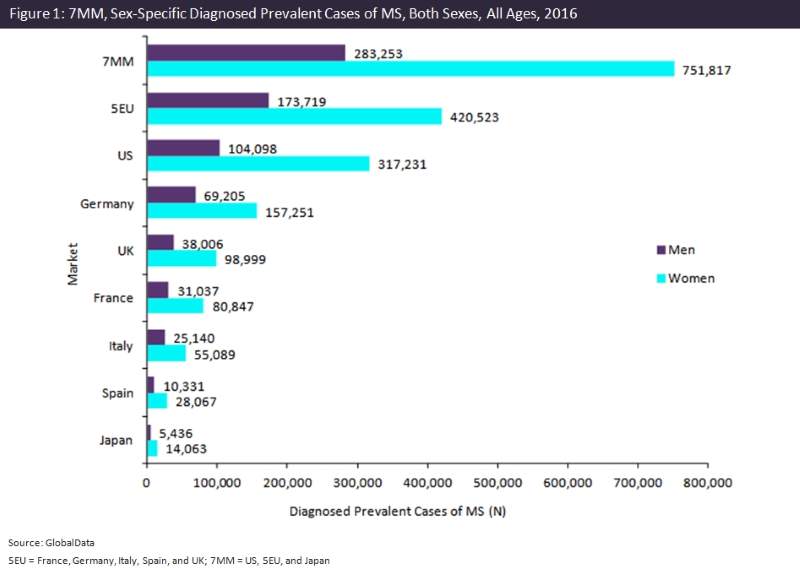Multiple sclerosis (MS) is an autoimmune disease that principally affects the central nervous system by causing nerve sheath damage and paralysis. MS symptoms include muscle weakness, weak reflexes, tremors, muscle spasms, prolonged double vision, slurred speech, and balance problems. It can occur at any age, but commonly affects people ages 15–60 years. The diagnosis of MS depends upon patients’ symptoms, magnetic resonance imaging (MRI) and laboratory results, but it is mostly diagnosed in the late phases of the disease. The risk of MS is higher in women; they are twice as likely to have MS as men.
GlobalData epidemiologists forecast that the diagnosed prevalent cases of MS in the seven major markets (7MM: US, France, Germany, Italy, Spain, UK, and Japan) will grow at an annual growth rate of 0.79% per year over the next 10 years, from 1,035,070 cases in 2016 to 1,116,491 cases in 2026. Of the 7MM, the US had the highest number of diagnosed prevalent cases with 421,329 (40.71%) cases in 2016, while Japan had the lowest number of diagnosed prevalent cases with 19,499 (1.88%) cases in 2016.
In the 7MM in 2016, diagnosed prevalent cases of MS occurred more than twice as often in women when compared to men. Women made up 72.63% of all MS cases, with 751,817 cases, while men accounted for 27.37% of all the MS cases, with 283,253 cases. In the US, the number of diagnosed prevalent cases of MS was much higher than in the other markets, with 317,231 cases in women and 104,098 cases in men. Japan had the lowest number of cases in women and men, with 14,063 cases and 5,436 cases, respectively.
Figure 1 presents the sex-specific diagnosed prevalent cases of MS in all ages in the 7MM in 2016.

The high women-to-men ratio in the prevalence of MS indicates the existence of an environmental or genetic factor influencing the disease, even though there is currently no strong evidence to support this assumption. This observation should prompt epidemiological studies that focus on the environment and genetics to better understand the factors leading to the difference in prevalence between women and men. As women are more at risk of developing MS, treatment priorities should be aligned to address this imbalance. Currently, there is no cure for MS. However, treatments can help speed recovery from attacks, modify the course of the disease and manage symptoms.

US Tariffs are shifting - will you react or anticipate?
Don’t let policy changes catch you off guard. Stay proactive with real-time data and expert analysis.
By GlobalDataRelated Reports
GlobalData (2017). EpiCast Report: Multiple Sclerosis – Epidemiology Forecast to 2026, November 2017, GDHCEM168-17
GlobalData (2017). PharmaPoint: Multiple Sclerosis – Global Drug Forecast and Market Analysis to 2024, September 2015, GDHC89PIDR




